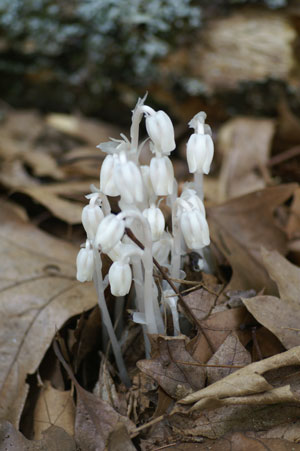Identifying the mycorrhizal partners of non-photosynthetic plants.
Monotropa uniflora, a non-photosynthetic plant that parasitizes mycorrhizal partners of other plants
In typical ectomycorrhizal associations, plants supply carbohydrates (sugars) to fungi, which reciprocate by facilitating uptake of phosphorous andopther nutrients
Not all ectomycorrhizal plants are capable of photosynthesis
Mycoheterotrophs are plants that parasitize mycorrhizal associations involving green plants—they are “cheaters”
Cullings et al studied the symbionts of the achlorophyllous rhododendron relatives, called “monotropes”, Pterospora andromedea, Monotropa hypopythis, M. uniflora, and Sarcodes sanguinea.
Cullings et al. amplified and sequenced a part of the mitochondrial large subunit rDNA from several monotropes, and comapred them to a sequence database of known ectomycorrhizal fungi by phylogenetic analysis
Results indicated that most monotrope species are highly specific for particular groups of fungi; i.e., evolution of a parasitic lifestyle is associated with a high degree of host specialization.
Fungal associates of monotropes included chanterelles (Cantharellus, cantharelloid clade), Russulaceae (Russula or Lactarius, russuloid clade), and boletes (Rhizopogon)
A similar pattern was found by Lee and Taylor, who studied diversity of fungi associated with nonphotosynthetic orchids—again, the fungi were highly speciec for particular fungal species, but this time the fungi were members of the russulaceae and thelephoroid clade (Tomentella, related to Sarcodon, Thelephora).
Studies by Bidartondo et al showed similar results in symbioses of non-photosynthetic liverworts (non-vascular plants related to mosses), which are associated with the genus Tulasnella (a group of resupinate forms, in the cantharelloid clade), and non-photosynthetic plants in the genus Arachnitis (related to orchids and lilies), which are associated with AM fungi in the Glomales.
Thus, a high degree of host specialization appears to be a general attribute of mycoheterotrophy, involving diverse lineages of plants and fungi.
References:
Bidartondo, M. I., D. Redecker, I. Hijri, A. Wiemken, T. D. Bruns, L. Dominguez, A. Sersic, J. R. Leake, and D. J. Read. Epiparasitic plants specialized on arbuscular mycorrhizal fungi. Nature 419:389-392.
Bidartondo, M. I., T. D. Bruns, M. Weiss, C. Sergio, and D. J. Read. 2003. Specialized cheating of the ectomycorrhizal symbiosis by an epiparasitic liverwort. Proc. Roy. Soc. Lond. B 270:835-842.
Cullings, K. W., T. M. Szaro, and T. D. Bruns. 1996. Evolution of extreme specialization within a lineage of ectomycorrhizal epiparasites. Nature 379:63-66. Hibbett, D. S. 2002. When good relationships go bad. Nature 419:345-346.
Taylor, D. L., and T. D. Bruns. 1997. Independent, specialized invasions of ectomycorrhizal mutualism by two nonphotosynthetic orchids. Proc. Nat. Acad. Sci. USA 94:4510-4515.

